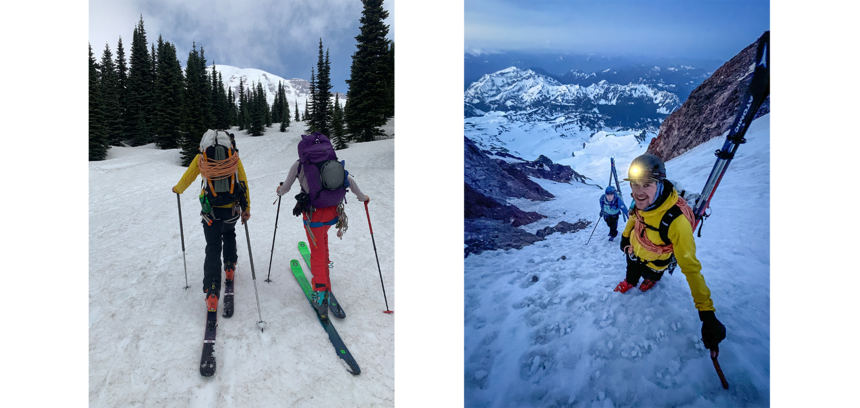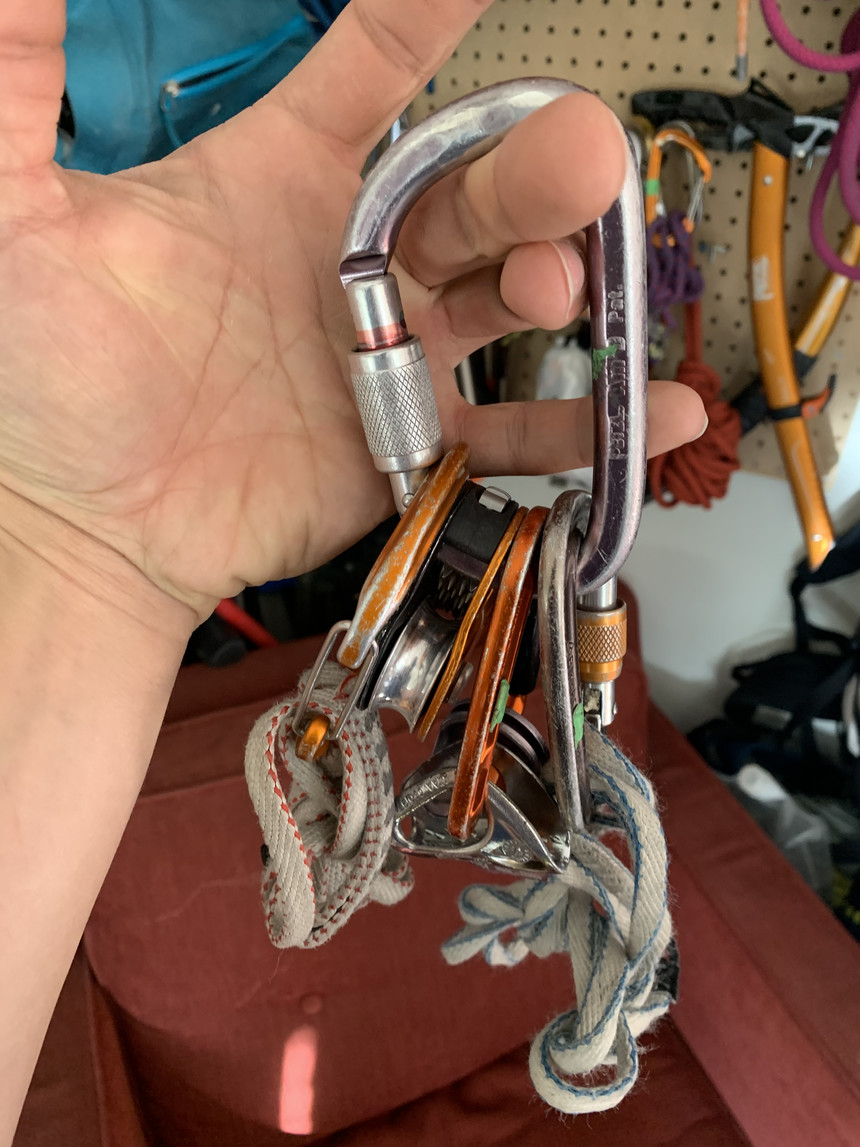
TGR TESTED: Fast-and-Light Overnight Ski Kit
Story by Max RitterThere’s this thing about big overnight ski missions that nobody really tells you about: the reality is that they’re usually pretty cold and miserable. Despite that, suffering through an uncomfortable night, carrying more gear than normal, and the problem of where to go to the bathroom are all eclipsed by the simple pleasure of dropping into a hard-earned line in untouched snow.
For most of the season, I’m the type of skier who would rather get up a little early and move a little faster to get up and down an objective in a day, but come springtime on big mountains like Mt. Rainier (Tahoma) the overnight option opens up new possibilities – and besides, spending the night at 10,000 feet on a glacier high above everything else is really something special. This spring, I took advantage of a healthy snowpack in the PNW to spend May on a few classic volcano descents, including a two-day mission on the south side of Rainier to climb and ski a 50 Classic line, the Fuhrer Finger. Of course, picking gear for a mission like this is a balancing act between performance, weight, and comfort. Besides bringing lightweight ski mountaineering skis and boots, picking the right overnight and mountaineering gear isn’t an obvious choice. Luckily, gone are the days of heavy packs, leaky tents and waiting forever for your water to boil. Here’s the overnight kit I brought up Rainier – for reference, my pack weighed in at 27lbs in the parking lot including food, 2L of water, and a camera.

Despite the unpronounceable name, Mountain Hardwear's Snoskiwoski Pack is one of the most functional lightweight packs I've ever used in the mountains. | Sophie Fearon and Lily Krass photos.
Mountain Hardwear Snoskiwoski 40 Backpack
Fun fact: The Snoskiwoski 40 is Mountain Hardwear’s first-ever ski mountaineering pack. Developed over a few years with input from athletes and guides, it’s designed to be a fast-and-light yet incredibly functional pack for big missions requiring more than the usual allotment of gear. At 40 liters, the pack is just big enough for an overnight requiring a tent and sleeping bag, but compression straps allow it to comfortably cinch down even when it’s not filled to the brim. The pack is constructed of recycled pfc-free cordura and nylon fabric, features a dedicated avalanche gear pocket, multiple ski and ice-axe carry options, skin pocket, external helmet carry, a side-entry zipper, padded hip straps with pockets, a rope strap, and a removable back pad. In other words, it’s fully loaded for a ski mountaineering pack – but weighs as much as tiny day pack. For Rainier, I was able to stow everything I needed inside the pack without feeling like it was going to explode. For technical glacier travel, the rope stacks nicely between the shoulder straps for easy deployment, or if you want to go full Vivian Bruchez, the interior hydration sleeve doubles as a rope stow, with an oversized port above the shoulder for on-the-fly rope feeding. Most importantly for big days, the shoulder and hip straps provide enough padding to make carrying the extra weight quite comfortable, even while skiing technical terrain.

If you have to carry a full-on four season tent into the mountains, it might as well be as light. BD's Firstlight tent is what I turn to when I want the comfort and storm protection of four walls and have to carry them all the way to the summit. | Sophie Fearon photo.
Black Diamond Firstlight tent
When on big mountains, the question of whether to even bring a tent is a valid one. On Rainier, for example, sleeping in a tent can provide some much-needed comfort for a few hours of sleep, but is it even worth the weight compared to an open bivy on a warm, clear night? Of course, with any chance of precip in the forecast, that choice becomes easier, but with Black Diamond’s Firstlight Tent, it’s much easier to justify bringing the creature comfort of a roof over your head just about every time. Why? It’s packs down to the size of Nalgene and at 1545 grams, it’s one of the lightest two-person floored winter tents on the market. I’ve used this tent on various overnight missions, but this was the first time I actually carried it for more than few hours and up significant vert – and when I zipped up my sleeping bag and closed my eyes for the night, I was mighty glad I brought it. One downside is the single-walled design is not exceptionally breathable; but sleeping with your head on the door/vestibule side makes a serious difference when it comes managing condensation. Inside, there are roomier options for two people, but let’s be honest, carrying an extra pound for a few extra inches of headroom really isn’t worth it.
Mountain Hardwear Phantom Gore-Tex 0F Sleeping Bag
In my opinion, the single most important piece of overnight gear you carry is your sleeping bag. It can mean the difference between getting that much-needed rest on a cold night, or it can literally be a lifeline in an emergency. That being said, the bag needs to pack down small enough for you to even carry it. Mountain Hardwear’s Phantom Gore-Tex 0F might be the ultimate solution to this issue. 850-fill goose down is packed into a Gore-Tex Windstopper shell, making the bag breathable, windproof, and highly water resistant. In other words, I’d sleep outside in this bag without a tent if I had to. At 1460 grams, the bag isn’t the absolute lightest option, but in this case, I’d rather carry a little more weight to ensure my comfort when the sun goes down.
NEMO Tensor Alpine Sleeping Pad
Inflating a sleeping pad at elevation is probably my least favorite part of mountaineering. Simply put, blowing really hard into a tiny nozzle is an easy way to quickly fade from consciousness. It seems like the great minds at Nemo have had similar thoughts, because the whole point of the Tensor Alpine sleeping pad is to eliminate the heavy breathing associated with pad inflation. Literally. The pad inflates using Nemo’s Vortex pump sack, which is an ultralight whoopie-cushion-shaped bag that clips into the pad’s valve allowing you to inflate the bag using 10 shallow breaths. Sound gimmicky? Well, it might be, but it works flawlessly. In terms of sleeping comfort, the pad inflates to 3 inches thick, providing enough stable and cushioned loft, plus a heat-reflective film inside provides a 4.8 R-Value, making the pad quite warm. With a packed weight of 555g including the Vortex bag, the Tensor Alpine pad is my go-to for cold nights in tent.
MSR Mini Pocket Rocket Stove Kit
So, you want to eat and drink while on your overnight on a big mountain? We definitely all do, but the single biggest source of pack weight is your food and water. Hydration and calories are something we literally can’t live without, but there are definitely ways to make it all lighter, and a good place to start is with your kitchen equipment. Eating dehydrated food (lighter and more packable!) requires you to add water somehow, but where does that water come from? Look around! You’re on a snowy mountain – all you have to do is melt snow. The same goes for carrying water on a multiday mission. Carry enough for a day, and melt snow every morning. MSR’s Pocket Rocket is a classic that’s been around for a while, but it works exceptionally well for fast-and-light mountain missions. In fact, it’s a tool I’ve even started carrying on long day missions for peace of mind in case of an emergency. It’s a super-simple isobutane canister stove that stows neatly in the included pot with a small fuel can. For a single overnight, that single small fuel can is barely enough fuel to melt water and cook for two, so bring an extra can if you don’t want to cut it close. It does not have a built-in ignitor, so whatever you do, don’t forget to bring a lighter!
Good-To-Go Dehydrated Meals
The second part of the lightweight food equation is the food itself. For the most part, dehydrated or freeze dried meals don’t just taste gross, they’re also filled with lots of questionable ingredients. As much as I like to cook myself, I’m the better half of Beyond Skid after all, cooking ultralight meals is not something I’m equipped to do myself. Luckily, that’s where meals from Good-To-Go come into play for me. I’ve tried a lot of backpacking food over the years and can truly say these are the best I’ve had, with the added benefit of knowing the ingredients are all things I’d keep in my own kitchen. As the package even says, “this isn’t space food.” In the mountains, I’m looking for the best calorie-to-weight ratio, and there a plethora of great options on the Good-To-Go menu. My favorites? Pad Thai (870 calories a pack) or Mushroom Risotto (820 calories a pack + it’s vegan). Brew up some water, pour it in the bag, give it a few minutes, and you’ll be surprised how well you can eat at high camp too!

That's all it takes to pull me out of a crevasse? Well, add a 30-meter Petzl RAD line and the answer is yes. | Max Ritter photo.
Petzl’s Fast and Light Skimo Kit
Well, the final way to save weight is of course in all the dangly bits you’re carrying up the mountain to keep you safe. Besides, if it’s light and small, you’re more likely to carry it. Big mountains are dangerous, and in my book, adding to the margin of safety is always a good thing. Most of these products aren’t new from Petzl, but taking the whole kit up Rainier this spring got me really stoked on how far this technology has progressed. For starters, the Petzl RAD line, albeit expensive, is a marvel of technical gear design. The 6mm cord is really the ultimate tool for ski mountaineering that requires ropework. Combine that with Petzl’s Crevasse Rescue kit (a Tibloc, a MicroTraxion, a lightweight pulley, and a few locking ‘biners) and Petzl’s Fly Harness, and you’ve got everything you would ever need to cross a glacier, rappel, and even rescue a partner – and it’s all svelte and lightweight enough you barely notice you’re wearing it. For steep ascents, I turn to Petzl’s ultralight and ultra-packable Leopard Crampons (they forego a metal bar, instead using ultralight dyneema cord to hold the toe and heel pieces together), and a pair of Petzl Gully ice axes. The added security of carrying two ice axes on Rainier was huge this year, as the classic route’s upper glacier is now unfortunately so melted out that the crux actually involved a few pitches of easy ice and mixed climbing.
